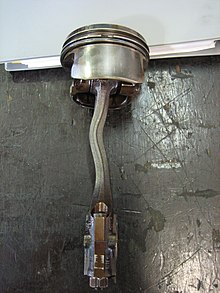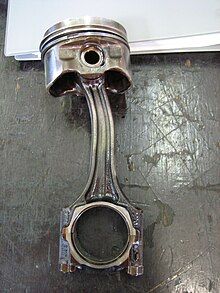Water hammer
As water hammer several are physical phenomena in which a strong water-designated surge is generated. The reason for this is the very low compressibility of water, which is only about a 20,000th of the compressibility of air.
In a figurative sense, water hammer means any mechanical impact from liquids.
Water hammer in piston engines
In the cylinders of piston engines gases with the initial volume V Hub + V rest in a considerably smaller residual volume V residual compressed. The compression ratio is often 10: 1 in normal operation . If there is water in the piston space, the remaining volume that is available to the gas at the end of the working cycle (i.e. at top dead center ) is reduced and can even become zero. As a result, the compression ratio at the end of the piston stroke takes on considerably higher values and the forces acting are multiplied. This always means that the components of the compression chamber ( piston , cylinder cover or head) as well as the drive parts ( piston rod , connecting rod ) are excessively stressed .
In the case of railways , water hammer refers to the damage to the cylinder caused by condensation . When the steam locomotive stops, the steam in the cylinder condenses into water. When restarting, under certain circumstances, the condensation on the exhaust stroke side cannot be pushed out and, due to lack of compressibility, usually tears the cylinder cover off the bolts . In order to avoid water hammers, the cylinder taps are therefore always opened briefly when starting to drain off condensation.
When water hammer also a (very rare) failure in is internal combustion engines designated when as a result of a leak in the cylinder head gasket cooling water passes into the compression chamber (which is designed for the compression of gases), and then in the compression stroke abruptly stops the piston - with the risk of a bent connecting rod , the piston ruptured and ultimately engine damage . With internal combustion engines in motor vehicles , water hammer can also occur when driving through water if the fording depth of the vehicle is exceeded and water reaches the compression chambers via the intake tract.
In sports boats with an internal engine compartment, water hammer can occur if water penetrates through the exhaust into the combustion chambers. This happens especially when the speed is not reduced slowly from full speed and the exhaust is relatively low.
Water hammer in water pipes
Water hammer is also a pressure surge in a pipeline carrying liquid , which is caused by the sudden closing of a valve at the end of the pipe . The inertia of the flowing water in the pipeline leads to an enormous increase in pressure because the compression module is very large. The flowing, cylindrical water column can be imagined as a model of a moving metal cylinder that is suddenly stopped on a wall.
A useful application of the pressure surge is the hydraulic ram , in which a large amount of water with a low height of fall is suddenly stopped in order to pump a small amount of water to a greater height (see energy conservation law ).
Water hammer can develop a damaging effect due to the pressure surge in the water pipes , which manifests itself as a leak in the pipe system or connected devices within a building. The pressure surge can be reduced by water hammer absorbers. These are small diaphragm expansion vessels (MAG) that are installed in the water pipe between the feeding pressure reducer and the valve that triggers the pressure surge. The closer the water hammer damper to the valve, the stronger the damping of the pressure surge. If there are several pressure surge triggers in different water pipes, the water hammer damper is placed between the feeding pressure reducer and the pipe division.
Alternatively, pressure surges can be reduced to a limited extent by reducing the amount of water flowing through and thus the flow velocity . This solution is considered a temporary solution, as it reduces the water flow at all taps .
Water hammer in steam systems
This condensation surge is a physical phenomenon that can be observed when pressure increases in steam systems. Within a steam amount are always condensation nuclei that with an increase in pressure without simultaneous temperature increase smallest drop of water can occur. This process does not take place continuously , but rather suddenly during the phase transition and is a great danger, e.g. B. for the pipes and machines of a steam power plant .
Steam hammer
Sometimes known as water hammer, this phenomenon occurs when steam bubbles implode in water .
Cavitation
Cavitation is a microscopic form of steam hammer.
Drop blow
Known as drop impact or drop erosion , this wear effect occurs when droplets hit a surface at high speed.
literature
- Friedrich Tölke: Publications on research into pressure surge problems in hydropower plants and pipelines. Volume 2, Springer Verlag, Berlin / Heidelberg 1956.
Individual evidence
- ↑ The pressure surge. Online (accessed July 30, 2018)
- ↑ Michael Löffler: Optimization of a piston steam engine with internal flash evaporation. Online (accessed July 30, 2018)
- ↑ Water hammer (accessed July 30, 2018)
- ^ Adolf Böhm, Heinz Moser (Ed.): Operation, maintenance and renewal of the water pipe network. Vulkan Verlag, Essen 1993, ISBN 3-8027-5501-4 , pp. 62-64.
- ↑ About devices to prevent water hammer in the cylinders of steam engines. In: Polytechnisches Journal . 282, 1890, pp. 173-174.
Web links
- Water hammer - steam hammer
- Pressure surges in valves - solutions for stability (accessed July 30, 2018)
- Liquid ring vacuum pump failure due to water hammer (accessed July 30, 2018)
- Water hammer (accessed July 30, 2018)
- Water hammer damper (accessed July 30, 2018)

